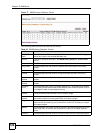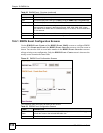
ES-1528 User’s Guide
133
CHAPTER 20
Dynamic ARP
This chapter describes how to activate dynamic Address Resolution Protocol (ARP) learning
and how to enter static ARP table entries.
20.1 ARP Table Overview
Address Resolution Protocol (ARP) is a protocol for mapping an Internet Protocol address (IP
address) to a physical machine address, also known as a Media Access Control or MAC
address, on the local area network.
An IP (version 4) address is 32 bits long. In an Ethernet LAN, MAC addresses are 48 bits
long. The ARP table maintains an association between each MAC address and its
corresponding IP address.
20.1.1 ARP Table Entries
The ARP table is populated with MAC and corresponding IP address mappings in two
different ways.
• DHCP Snooping - The switch listens to traffic from a DHCP server on a trusted port and
learns IP-to-MAC address bindings by parsing DHCP ACK packets.
• Static Entries - The switch administrator can enter static IP-to-MAC address mappings
via the web configurator.
20.1.2 How Dynamic ARP Works
When an incoming ARP packet destined for a host device on a local area network arrives at
the switch, the switch's ARP program looks in the ARP table and, if it finds the address, sends
it to the device.
If no entry is found for the IP address, dynamic ARP discards the ARP packet. broadcasts the
request to all the devices on the LAN. The switch fills in its own MAC and IP address in the
sender address fields, and puts the known IP address of the target in the target IP address field.
In addition, the switch puts all ones in the target MAC field (FF.FF.FF.FF.FF.FF is the
Ethernet broadcast address). The replying device (which is either the IP address of the device
being sought or the router that knows the way) replaces the broadcast address with the target's
MAC address, swaps the sender and target pairs, and unicasts the answer directly back to the
requesting machine. ARP updates the ARP table for future reference and then sends the packet
to the MAC address that replied.


















